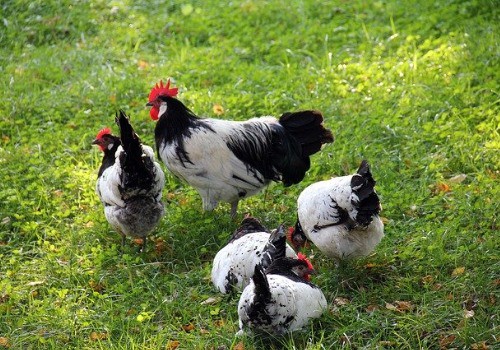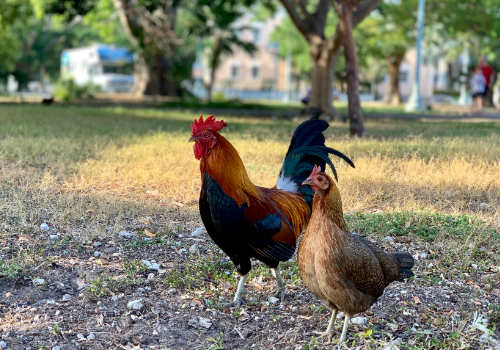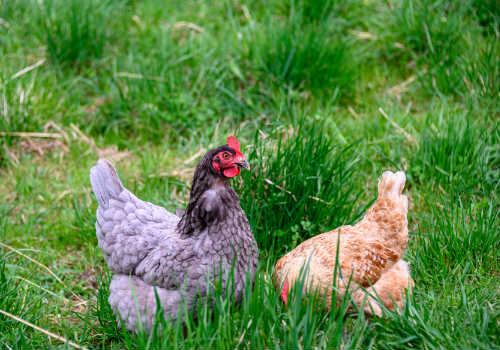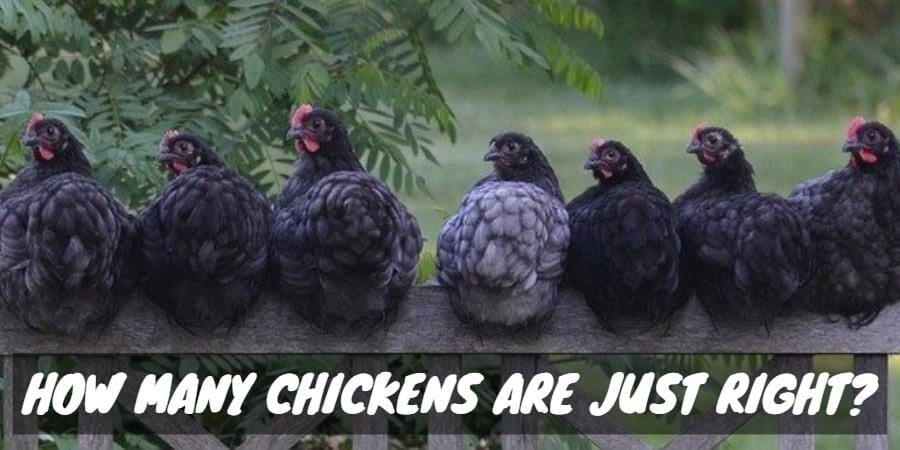Raising free-range chickens require a different mindset than raising chickens in a coop. While a coop is designed in a way that’s easy to secure, free-range birds will have much less protection from predators and weather. The first thing to keep in mind is that there are two types of free-range chickens. The first one is total free-range.
Total free-range chickens run free all day. When night comes, they are lured back into a coop using feed so that they can roost and be safe from predators.
The other type of free-range chickens is secured inside of a chicken coop with a run that goes outside.
In more recent years, we’ve started to see a trend that falls somewhere between those two. Backyard flocks are cropping up all over the place so we’re seeing confinement with moderate amounts of free-ranging. This is normally called
What Does Free-Range Mean for Chickens?

There are a couple of definitions that we can use here.
The first is reserved for commercial chickens in which the USDA sets the standards that must be applied for chickens sold as “free-range.” They require chickens to be given access to outdoor space at all times. Most people imagine that free-range chickens are given free rein of open fields and pastures all of the time, but that is not the case at all. Commercially speaking, as long as chickens have access to an open field of gravel for just a few minutes per day, then they are considered free-range.
Homesteading is a whole different ballgame though! If you raise chickens in your backyard as free-range, flocks are allowed to roam around outside for most of the day. These flocks are allowed to move freely in open fields.
When most people say their birds are free-range, they mean their chickens are given access to the outdoors at all times. They are fed daily but allowed to come and go from the coop as they please. Now, these chickens usually have two different yards that they roam around in. One yard is larger than the other. They can be closed off in the smaller area at night, so they are safe from predators. So free-range is not necessarily free-running birds in open plains all day long. It’s more like chickens are let out into the large field every day and then tucked away in their home at night. Their home is also rather large too.
For instance, if it’s breeding season for hawks then it’s best to feed chickens in the morning and then let them out a little later in the day. Then you can allow the chickens to roam all day until they will put themselves into roost.
Once the temperature starts dropping, you can start feeding them later in the evening, so it’s easier to get them into their sectioned off yard. You want to do this because predators are aggressive during the winter. It’s all relative to where you live and how you want to raise your flock.
[amazon bestseller=”checken feed”]
How to Raise Free-Range Chickens in the Winter

This is a whole different ballgame, and you have to put yourself into a different mindset, especially if you get a lot of snow in your area. Chickens are going to stay close to their coop during the colder months. Plus, they are not going to scratch through deep snow for feed. If you live in an area that tends to get snow, you might find that it’s best to only let chickens out of their smaller yard for a few hours per day. Most of them might not even leave the coop.
Sometimes, it’s best to leave them in their run. If you do this, make sure they are adequately entertained to that it’s easier on them. Chicken swings and toys are great additions to any run. Adding bales of hay will also give chickens something to scratch through. Offering special treats like hot oatmeal and baked squash is another great method of entertaining chickens.
Chickens can fight off cold weather until around 10 degrees Fahrenheit, but they’re still susceptible to frostbite. When it’s snowing out, chickens need a way to get themselves off the ground. Snow free areas for scratching around are also essential for free-range birds.
Do Free-Range Chickens Need Heat?
This is a frequently asked question that a lot of new chicken farmers will ask me. I think the answer is going to be different for everyone depending on where you live. There are just so many ways that you can raise chickens that there is no definitive “best way.” But I will give you some advice that I’ve learned through experience.
If the temperature is going to drop below 25 degrees, then you should probably find a way to heat the coop. There is no need to force chickens from the run into their coop. Trust me; they will find their way to the warmest spot. Most farmers set up heat lamps on one side of the coop so that chickens can adjust to their level of comfort. You can choose to feed chickens inside of their coop at around 5 pm to lure them in. Then you can close the door. It depends on how cold it’s going to get and how old the birds are.
[amazon bestseller=”chicken coop heater”]
Heating is only one factor when the weather gets cold. Freezing weather brings about a wide array of other problems. One of which is that it will freeze drinking water, so you need to make sure you check this several times per day. You’ll also need to feed them more during the winter so that they can put on extra weight.
11 Advantages of Free-Range Chickens

One cool fact of free-range chickens is that they are going to be consuming mostly protein in their diet. Natural, high-protein diets are one of the advantages of free-ranging. This will help chickens lay eggs that are gorgeous. Imagine breaking open an egg with a beautiful yellow
- Free-range chickens are able to stay entertained because they get the chance to roam around, scratching for feed. Their natural impulses are met.
- Free-ranging chicks will actually save you money since they require less feed.
- All nutritional requirements are met because chickens are going to search for the right types of food.
- Chickens will create their own dust baths which reduces the chances of
a lice or mite infestation. You can also build dust baths in their run to make it easier on them. - There is no need to put out grit since chickens will find their own.
- Free range chickens are physically fit. Plus, they maintain a healthy weight.
- They lay better tasting eggs.
- Chickens will eat bugs and spiders around your home.
- They will till your garden beds, saving you some work.
- Chickens will provide fertilizer to your gardens.
- Flocks have what is known as a pecking order. Meaning that when you confine them, you run the risk of some chickens being bullied away from food and water. Free-range chickens don’t tend to have this problem.
7 Disadvantages of Free-Range Chickens
- There is one thing that we can all agree on. We want our flocks to thrive. That means they need to be as happy and healthy as possible. What’s important is that you pay attention to your flock. They will show you what they need if you know what to look for. Chickens leave poop everywhere
- They are at a larger risk of being nabbed by predators
- Chickens will eat everything, including flowers and some other items you’d rather them not eat. Make sure you secure your flower gardens!
- Until you train them to lay eggs in their nest, they will not; They will lay wherever they want
- Chickens can find ways to get out of their yard
- They will scratch up your flower beds to make dust baths
- Until they are trained, it’s difficult to get them to come to roost at night

There is one thing that we can all agree on. We want our flocks to thrive. That means they need to be as happy and healthy as possible. What’s important is that you pay attention to your flock. They will show you what they need if you know what to look for.
Teaching Free-Range Chickens to Lay Eggs in Coop
One of the best ways to teach hens to lay eggs in a specific area is to confine them to that area when it’s time for them to start laying eggs. You’ll know it’s time when their cones and wattles start turning red. They will also squat when walking. Hens squat so that roosters can fertilize their eggs.
You can also place ceramic eggs in the nests for the hens to see. Then give them a few weeks of laying eggs in those nests to make sure that they understand the routine. After which, you can start to completely free-range the flock.
How Much Land Do Free-Range Chickens Need?
The rule of thumb for free-range chickens is about 80 hens per acre. It’s important to remember that free-range and yarding are two entirely different concepts. Most of us are just yarding chickens, which is a method of free-range, but it is not fully free range. If you are working with half-an-acre, then 40 hens will likely be your limit for free-ranging. But if you are yarding, then you can cut that in half and keep 40 hens in a quarter-acre.
You’re looking at approximately 400 square feet per chicken.
Chickens do not like to travel far, so they are going to spend most of their time in an area within 150 feet of the hen house. But you can spread them out even further by feeding them away from the hen house during the day.
There are specific legal definitions for free-range chickens.
In the EU, this legal definition is 13 square foot per chicken for free ranging. But this law does not actually specify how often farmers have to let their birds outside.
In the United States, the legal definition for free-ranging does not have a specific number defining the size of your
I define free-range chickens as having access to at least 25 square foot (per bird) of outdoor space. Predators require us to have a run that protects them our chickens so make sure your birds are safe.




